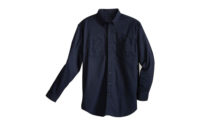OSHA considers garments to be PPE, according to OSHA Regulation 29 CFR, 1926.95(a). Additionally, a letter from the Director of the OSHA Directorate of Construction details regulations in which employers must comply with laundering standards:
“Pursuant to the requirements of 29 CFR 1926.95(a), the standard does not prohibit home laundering of FR and arc-rated clothing if the employer permits it. However, to comply with 1910.132 or 1926.95, the employer cannot simply instruct employees to follow manufacturers' instructions. Employers must ensure that protective clothing such as FR garments are adequately maintained in a reliable condition such that if the FR garment is challenged in a flash fire, the garment will perform as designed.
“In other words, the employer is responsible for ensuring that the FR garment is laundered such that contaminants (e.g. dirt, oils, etc.) will not affect the performance of the garment when it is in use. If employers rely on home laundering of the clothing, they must train their employees in proper laundering procedures and techniques, and employers must inspect the clothing on a regular basis to ensure that it is not in need of repair or replacement. If an employer cannot meet these conditions, then the employer is responsible for laundering the FR and arc-rated clothing.”
As such, employers have a greater responsibility than they did in the past for the laundering of flame- resistant clothing (FRC) that their employees wear on the job.
An array of accountability
FR garments are typically laundered at home by the wearer or by a uniform service provider under contract with the employer. Regardless of the method of laundering, employers face greater responsibilities now than in the past for training workers in proper care and maintenance of FRC.
As specified in the OSHA interpretation above, employers must also inspect garments to determine when repair or replacement is warranted. While not specifically mentioned in the OSHA memo, the wearer is also responsible for maintaining their PPE—after all, it’s for their protection. Garments whose protection may be compromised by damage or contamination should be reported and repaired or replaced before returning to the job. Garments contaminated with flammable materials cannot resist ignition and self-extinguish as designed. Flammable contaminants include the more obvious materials like oil and grease, but less obvious things like paint, some types of dust, creosote from telephone poles, some insect repellents, bacon grease, flour, sugar, non-dairy creamer, and more can ignite when exposed to flames.
Care and cleaning the right way
A recent study of 400 environmental, health and safety professionals, conducted by Mount Vernon FR in conjunction with the American Society of Safety Engineers (ASSE), found that only 29 percent of respondents said that they are extremely familiar with FRC care and maintenance.
The study sheds light on why it is important to educate employees about proper ways to launder FRC at home, allowing garments to perform as designed for their full-service life.
Tips for proper care and maintenance
- Flame-resistant clothing should be laundered separately from the family wash to prevent cross-contamination.
- Washing at home may be done with typical home laundry powdered detergents. Powdered detergents containing "color safe" bleaches such as sodium perborate may be used. Wash on the permanent press cycle with the wash temperature set to warm or hot.
- If stain removal is required, commercial stain removal products that do not contain hydrogen peroxide are acceptable. Detergent can also be poured directly onto the stain to aid removal. Heavy stains may not be completely removed, but the presence of a visible stain doesn't necessarily compromise the flame-resistant characteristics of a garment.
- Dry on the medium heat setting, but do not over-dry the garments to avoid excessive shrinkage. If desired, garments may be ironed on the permanent press setting.
- Products to avoid: Liquid detergents or other products that contain hydrogen peroxide may affect the protective properties of the garment and should not be used. Products such as starch, fabric softener or any other laundry additives, such as dryer sheets, must not be used. Chlorine bleach must never be used.
Ultimate goal
Always double check your PPE garment manufacturer’s guidelines before laundering them. Careful attention to care instruction will help to maximize the service life of the garments and insure they retain their FR properties.
Dispose of garments that are worn and have holes in them, along with those that are stained with a flammable substance that cannot be removed with laundering. Failure to care for your PPE garment could potentially result in injury to the wearer.



